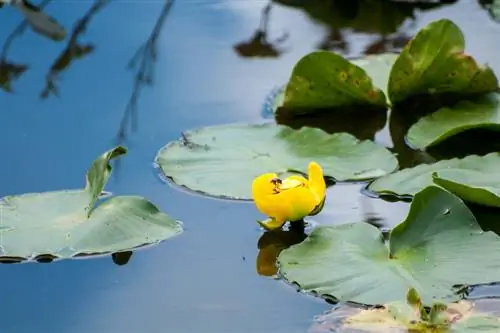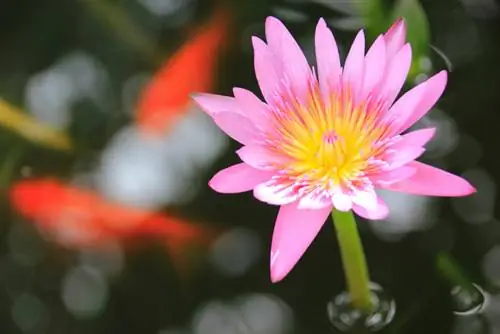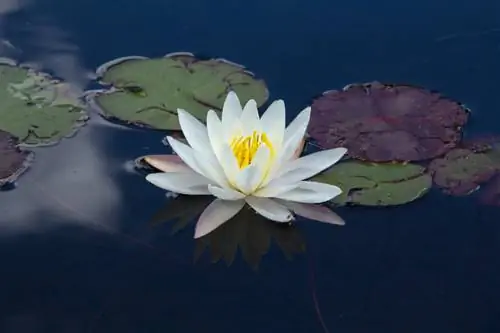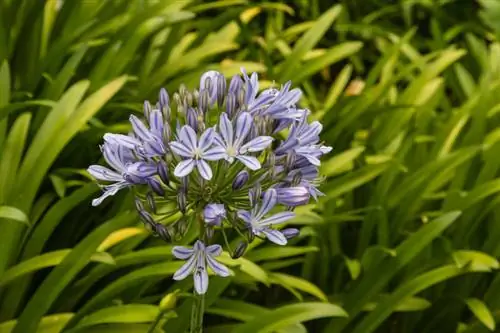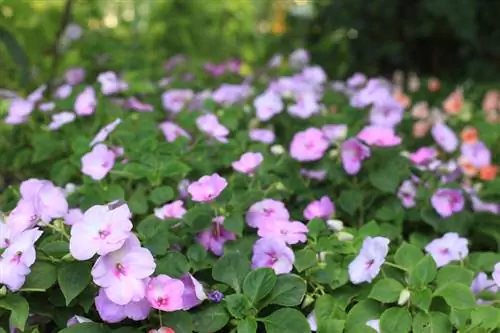- Author admin [email protected].
- Public 2023-12-16 16:46.
- Last modified 2025-01-23 11:22.
Read a water lily profile here with information on growth, leaves, flowers and occurrence. Correct planting as a step-by-step guide. Care tips worth knowing for a magnificent mummel in the garden pond.

What is a water lily and where is it found?
The pond lily (Nuphar lutea) is a native aquatic plant that occurs in stagnant and slow-flowing waters. It is characterized by floating leaves and spherical, yellow flowers. Pond lilies are hardy, easy to care for and ideal for use in garden ponds.
Profile
- Scientific name: Nuphar lutea
- Family: Water lilies (Nymphaeaceae)
- Synonym: mummel, pond mummel
- Occurrence: Europe, North Africa, Siberia
- Growth type: perennial, aquatic plant
- Growth height: 5 cm to 20 cm
- Growth width: 120 cm to 250 cm
- Flowers: spherical
- Leaves: floating leaves
- Root: Rhizome
- Winter hardiness: hardy
- Use: Garden pond
Occurrences
The yellow pond lily (Nuphar lutea) is one of the native aquatic plants and is also known as mummel and pond mummel. Their natural range extends over large parts of Eurasia to Siberia. The water lily plant can also be found in North Africa, the eastern regions of the USA and the Caribbean. Preferred habitats are stagnant and slow-flowing waters with a water depth of 60 cm to 200 cm. Therefore, pond lilies have similar environmental requirements as water lilies (Nymphaea).
Growth
With its picturesque appearance, the pond lily is perfect for the large garden pond. All important key growth data in brief:
- Growth type: perennial, herbaceous aquatic plant with floating leaves, above which yellow spherical flowers are enthroned on the long stem.
- Growth height above the water surface: 5 cm to 20 cm during the flowering period.
- Total height: 65 cm to 220 cm (according to the water depth).
- Growth width: 120 cm to 250 cm.
- Roots: fleshy, branched rhizome as a survival organ, 3 cm to 8 cm in diameter.
- Gardeningly interesting properties: hardy, easy to care for, tolerates cutting, toxic, filters the pond water.
Video: Interesting facts about the yellow pond lily - Nuphar lutea
leaves
A water lily forms two types of leaves with these identifying features and special features:
- Floating leaves: stalked, shiny dark green, heart-shaped, entire, up to 30 cm wide and 40 cm long.
- Underwater leaves: light green, wavy leaf edge, lettuce-leaved.
- Special feature: Floating leaves die off in autumn, underwater leaves remain green in winter.
The different leaves fulfill important tasks for fish and water quality. In summer, the powerful floating leaves serve as sun protection and a retreat for koi, goldfish and other aquatic creatures. At any time of the year, especially in winter, the underwater leaves filter the water and enrich oxygen.
Flowers
In summer, decorative flowers with these characteristics rise above the floating leaves of a water lily:
- Flower shape: long-stemmed, spherical to hemispherical, 4 cm to 12 cm in diameter.
- Flower structure: 5 yellow sepals, 25 yellow petals, numerous yellow stamens.
- Flowering time: June/July to August/September.
- Special feature: Single flowers bloom for one day.
- Flower ecology: hermaphrodite, intensely fragrant, rich in nectar.
- Pollinators: beetles, hoverflies.
Pollinated pond lily flowers become 2.5 cm large capsule fruits with numerous, olive-green seeds. These seeds are buoyant and are cold germinators.
Excursus
Pondroses are poisonous
All parts of a pond lily are poisonous. The toxic substances are primarily the two alkaloids nupharin and nupharidine. The highest concentration of poison is in the rhizome. Intentional or unintentional consumption causes headaches, nausea and even respiratory paralysis. Skin contact causes excruciating itching. Wearing gloves is strongly recommended for all care and planting work.
Planting a pond rose
The best time to plant pond lilies is early to mid-May. When choosing a location in a garden pond, important criteria must be taken into account, from lighting conditions to planting distance to water depth. Ideally, a mummel is planted in stages. You can find out where and how to properly plant the yellow water lily here:
Location
Polar roses bloom best in sunny to partially shaded locations. In contrast to the closely related white water lily (Nymphaea alba), a mummel also thrives in shady pond areas. In low-light locations, however, slight reductions in the flower splendor must be accepted. The spatial proximity to water features or a waterfall in the garden pond is possible because pond lilies also occur in slow-flowing water.
Planting distance, water depth
If pond lilies are planted too closely, the floating leaves get in each other's enclosure. As a result, the aquatic plants keep their flowers under wraps. In water that is too low or too deep, a water lily will also not bloom or will bloom poorly. For better orientation, the following table compares important planting dates for the large, native pond lily and the small, naturalized pond lily:
| Planting data | Yellow pond lily | Little pond lily |
|---|---|---|
| Botanical name | Nuphar lutea | Nuphar pumila |
| Planting spacing | 150-180 cm | 25-30 cm |
| Water Depth Minimum | 60cm | 20cm |
| Water depth maximum | 200cm | 60cm |
| Water surface | 2 m² | 0, 5 m² |
First step: plant in the plant basket
A water lily is not planted directly in the bottom of the pond, but rather sunk into the plant basket. Special water lily potting soil or a mix of equal parts clay and sand, enriched with horn shavings, is suitable as a substrate. This is how it works:
- Fill the plant basket 2/3 full with substrate.
- Lay the rhizome of the water lily flat on the substrate.
- Fill the remaining potting soil so that the buds of the shoots protrude from the substrate.
- Press down the soil and mulch with coarse gravel as weight.
Second step: plant in the garden kingdom
For a water lily, planting is a gradual process. The aquatic plant is gradually brought to the final water depth. How to do it right:
- Stack clean bricks at the location as a platform.
- Place the plant basket on the platform (substrate surface is 10-20 cm below the water surface).
- Remove the top brick when the first floating leaves touch the water surface.
Each additional brick is removed as the leaves reappear on the surface.
Take care of the pond rose
The pond lily is undemanding and easy to care for. Fertilizing when necessary and occasional pruning are beneficial for well-maintained, flower-rich growth. Even beginners master the uncomplicated propagation with flying colors. Care instructions worth reading for a mummel worth seeing in the garden pond:
Fertilize
With deficiency symptoms, a water lily signals its need for fertilizer. Typical symptoms of nutrient deficiency include yellowing leaves and stunted flowers. Because even a slight over-fertilization can trigger the dreaded algae bloom in the garden pond, add an organic fertilizer directly to the plant basket. The following trick has proven itself well in practice:
- Stir horn flour into water.
- Pour liquid into an ice cube mold and freeze.
- Press the frozen fertilizer cube into the plant basket substrate.
Cutting
Pruning every two to four years is crucial for the lush yellow pond lily flowers. Otherwise, floating leaves will spread over the entire surface of the water and the water lily will no longer bloom. The best time for pruning care is in spring and summer. Using telescopic pond scissors (€69.00 on Amazon), you can cut off some floating leaves and underwater leaves from the bank. Make the cut as close as possible to the root ball.
The easiest way to get the clippings out of the garden pond is with a landing net. Please put on gloves to prevent skin contact with the poisonous plant sap.
Propagation
You can propagate the pond lily by sowing using its floating seeds as light and cold germinators. Vegetative propagation is easier through division. How to do it right:
- Lifting the pond rose out of the water in spring.
- Put on gloves.
- Remove plant basket.
- Rinse the rootstock to expose the branched rhizome.
- Cut off 15 cm long rhizome pieces with a sharp knife.
- Disinfect cuts with activated carbon powder.
- Plant each rhizome piece in a pond basket and place in the garden pond (see planting instructions).
Wintering
The native mummel is completely hardy. No special winter protection measures are required. In contrast to the wintergreen underwater leaves, the floating leaves move in in autumn. It makes sense to cut at the right time so that the dead plant parts do not sink to the bottom of the pond and cause rot. Cut off a floating leaf as soon as it begins to wilt.
Popular varieties
In the large garden pond, the native yellow pond lily (Nuphar lutea) enjoys decorative company from these conspecifics and varieties:
- Dwarf pond rose 'Variegata' (Nuphar pumila): hardy mini-mummel with green-yellow variegated floating leaves for a water depth of 20-40 cm.
- Japanese water lily 'Rubra': Japanese water lily, orange-red spherical flowers, also blooms in shady areas, water depth up to 50 cm, moderately hardy.
- American water lily (Nuphar advena): strong-growing, rich in flowers, water depth up to 120 cm, space requirement 1.5 to 2 m², hardy, shade-tolerant.
- Rubrotincta: Japanese water lily (Nuphar japonica), medium growth, reddish-brown underwater leaves, water depth up to 80 cm, leaves stand up at an angle in shallow water.
FAQ
When can you plant pond lilies?
With the beginning of the frost-free growing season, the time window for planting pond lilies opens. The planting time for the hardy aquatic plants extends until mid/late October. The best date is from the beginning to mid-May so that the rhizomes can build up vigorously until the beginning of winter.
Does the pond lily need a plant basket or do I just put the aquatic plant in the bottom of the pond?
To successfully plant a water lily, please use a plant basket. Place this on a brick platform so that the floating leaves are about 10 centimeters below the water surface. Once the leaves have reached the surface of the water, a brick is removed. Continue like this until the plant basket is on the bottom of the pond.
Is the pond lily poisonous?
A water lily (Nuphar lutea) is poisonous in all parts. There is a high concentration of toxic alkaloids, especially in the fleshy rhizome. If the poisonous plant sap gets on human skin, severe itching can result. Anyone who comes into close contact with a mummel during care and planting work should therefore wear gloves and long-sleeved clothing.
How are Japanese pond lily and yellow pond lily different?
A Japanese pond lily (Nuphar japonica) does not grow so much, thrives in a water depth of 20 cm to 50 cm in a temperature range between 10° and 28° Celsius and takes up a water area of around 0.5 square meters. Due to limited winter hardiness, the Asian Nuphar species needs to be frost-free over the winter. In contrast, the yellow pond lily thrives in a water depth of up to 200 cm, takes up up to 2 square meters of the water surface and is completely hardy.
What is the solution for water lily in the crossword puzzle?
We have the following suggested solutions: Water lily with 6 letters 'Nuphar' or 'Mummel'. Water lily with 8 letters 'Nymphaea'. Water lily with 11 letters 'Pond Mummel'. More rarely, a crossword puzzle asks for a water lily with 7 letters. Then the answer is 'water lily'.


